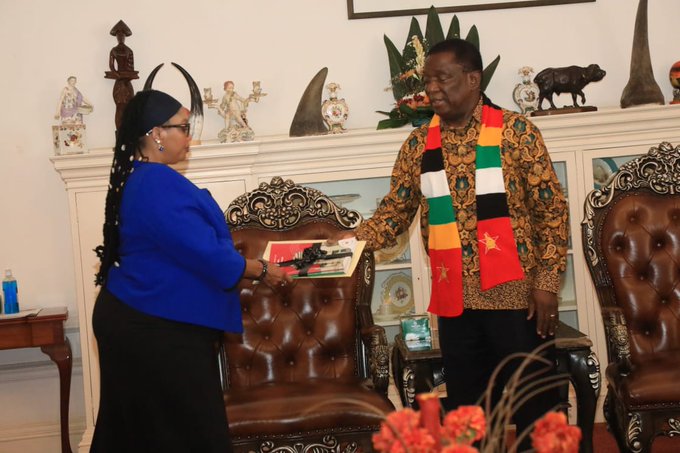President Emmerson Dambudzo Mnangagwa presents parliament delimitation report to the Zimbabwe Electoral Commission (ZEC).
The President presented the report to ZEC chairperson Priscilla Chigumba at State House in Harare this morning.
Parliamentary Ad Hoc Committee Report
The committee began by expressing its appreciation of the work done by ZEC but set out aspects of the report that caused concern.
These may be summarised as follows:
ZEC did not use census data correctly to delimit electoral areas
The committee noted that ZEC relied on preliminary census figures for the delimitation exercise because the final census report had not been finalised and published. The committee accepted that ZEC had to do this to comply with its constitutional obligations, but took issue with the fact that ZEC considered only the adult population rather than the entire population.
This, the committee said, did not conform to the values and principles set out in section 3(2)(j) and (l) of the Constitution, which relate to the equitable sharing of national resources, including land and devolution funds.
Comment by Veritas Zimbabwe: It is true, as the committee said, that wards are important for administrative purposes unconnected with elections, but delimitations under section 161 of the Constitution are concerned solely with elections.
Hence, with respect, ZEC was right to look at the figures for the adult population since it was concerned with locating adults, most of whom are voters, rather than children who cannot vote.
The equitable sharing of national resources, though important, has little to do with delimitation of electoral boundaries.
Some electoral areas had too many voters and some too few
The committee noted that ZEC possibly misinterpreted section 161(6) of the Constitution, which states that no constituency may have 20 per cent more or fewer voters than other constituencies, and imposes the same limit on wards in a council area.
This misinterpretation, the committee said, led to some constituencies and wards varying by up to 40 per cent.
Comment by Veritas Zimbabwe: We made this point in our Election Watch 2/2023. ZEC undoubtedly did misinterpret section 161(6), as it made clear in paragraphs 4.1 and 4.2 of its own report.
ZEC did not take sufficient account of the factors set out in section 161(6) of the Constitution
The committee considered that ZEC did not pay enough attention to physical features, means of communication, community of interests and other factors set out in section 161(6) of the Constitution.
The report did not give the reasons for combining constituencies and wards
The report merely described the new electoral boundaries and did not provide any justification for them. The committee said that, in the interests of transparency, justice and fairness, ZEC should have stated in the report its reasons for combining (“collapsing”) constituencies and wards, because in many cases the reasons were not apparent.
ZEC did not consult stakeholders
According to the committee, ZEC did not comply with section 37A of the Electoral Act and consult stakeholders fairly, particularly traditional leaders. As a result, in some areas voters were moved to different constituencies and wards from their traditional leaders.
Descriptions of electoral boundaries were not clear enough
The committee considered that the co-ordinate system used to describe electoral boundaries was too complicated for ordinary people to understand.
The maps accompanying the report were inadequate
The maps did not indicate their scale, and ZEC was unable to tell the committee what scale had been used. Whatever their scale the maps did not show topographical features, which would assist in identifying some electoral boundaries, nor they show population densities. Also, the maps did not show existing electoral boundaries, which would have been useful for comparison purposes.
Some wards were not labelled on the maps
The committee found it difficult to identify wards that were not labelled on the maps, since the narrative descriptions of the wards were not clear enough.
Polling stations were not shown on the maps
The committee noted that locations of polling stations were not indicated on the maps, and the fact that the map scales were not given made it difficult to compute the time it would take people to walk to their nearest polling station.
Comment: It would be useful to know where polling stations are to be situated, to see how far voters in the new electoral districts will have to travel in order to cast their votes. That said, the location of polling stations is not an essential part of delimitation under the Constitution.
The Commissioners did not sign off on the report
The committee noted that ZEC’s commissioners had not signed the report.
Comment: A photograph circulating on social media at the end of last year purported to show that all commissioners, except the chairperson and vice-chairperson, had signed the report – though curiously on the 6th December, whereas the report was presented to the President on the 26th.
The Ad Hoc Committee’s Recommendations
The committee made the following recommendations:
· ZEC should take into account the entire population as shown in the census, not just the adult population, because wards serve other purposes apart from elections.
· ZEC should revisit boundaries where it did not take account of community of interests between voters.
· ZEC should ensure that there are equal numbers of voters in constituencies and wards, with variations limited to 20 per cent as required by section 161 of the Constitution.
· ZEC should apply consistent principles when transferring voters from constituencies and wards with large numbers of voters to those with fewer.
General comment
The issues raised by the ad hoc committee are important and its recommendations are generally sound. The committee is to be congratulated in producing such a commendable report in the very short time available to it.
What Happens Now
Both Houses of Parliament will be debating the ad hoc committee’s findings and recommendations today and tomorrow, and will present their own findings and recommendations to the President on Thursday the 19th January.
Then, if either House has recommended that the delimitation report be referred back to ZEC (and both Houses will probably recommend this), the President will have to send it back to ZEC for reconsideration – and he will have only one day to do so, because section 161(8) of the Constitution says that the report must be returned to ZEC within 14 days after it was laid before Parliament.
If, as seems likely, the report is referred back to ZEC, the Commission will have to consider the issues raised by Parliament, in addition to any the President himself may raise, but ZEC’s decision on them will be final.
Then ZEC will send its final delimitation report to the President and he will publish it as a proclamation in the Gazette. As we said in our Election Watch 2/2023, the absolute deadline for the report to be published is the 26th February.
Can ZEC meet this deadline? Its deputy chairperson has said it will look into all the issues the ad hoc committee has raised, so long as they are within the ambit of the law. Some of the issues though are fundamental and will require drastic revisions of the preliminary boundaries.
ZEC may be able to do it, but will have to work very hard indeed, particularly if it engages in consultations with stakeholders which it should have done in the first place.














